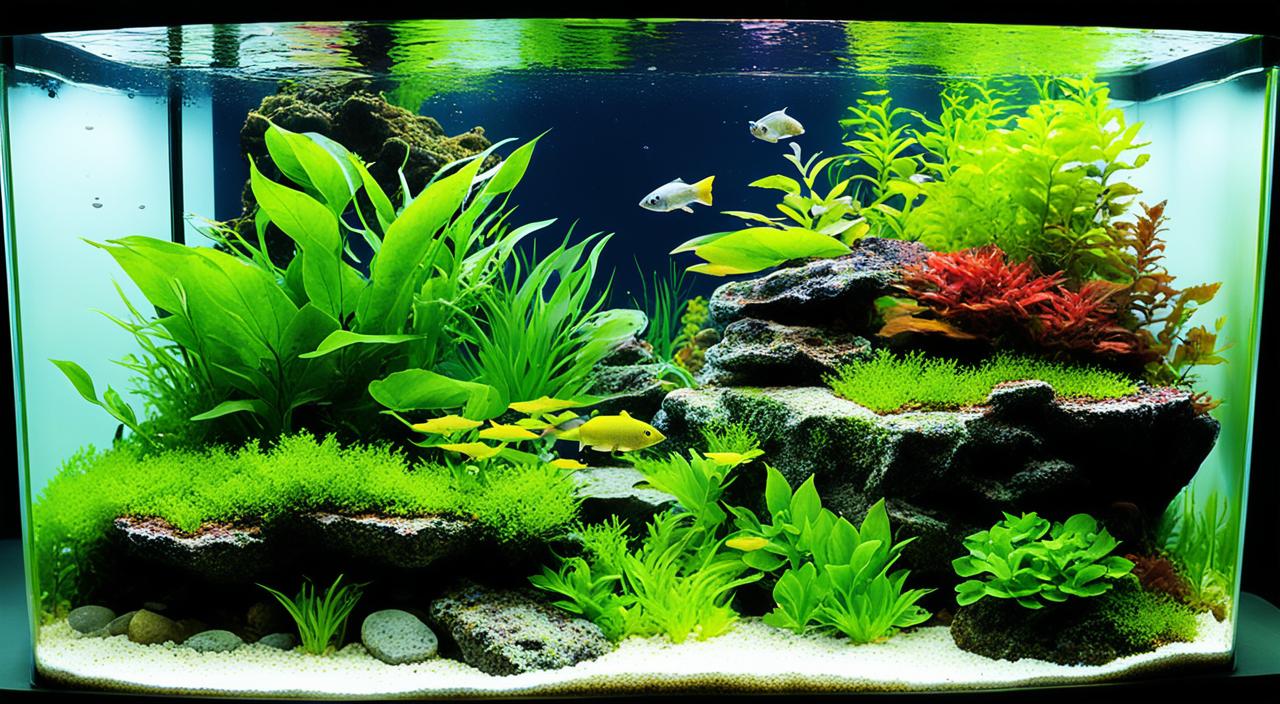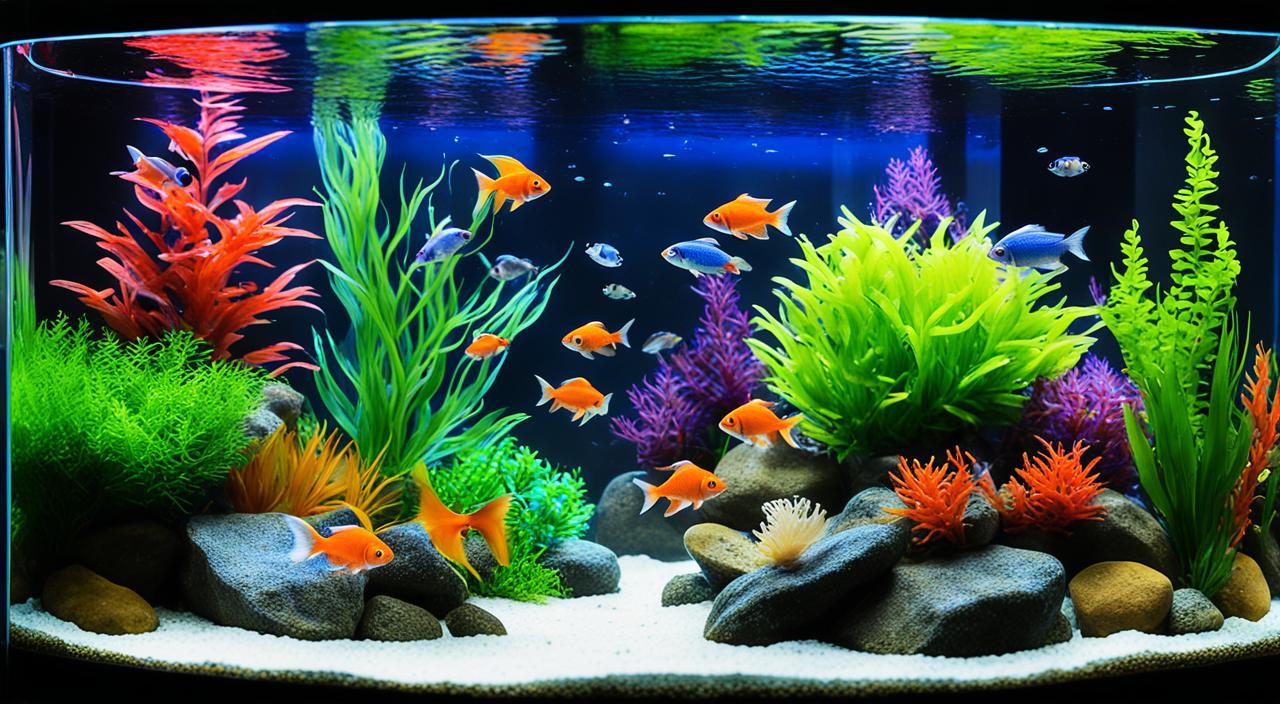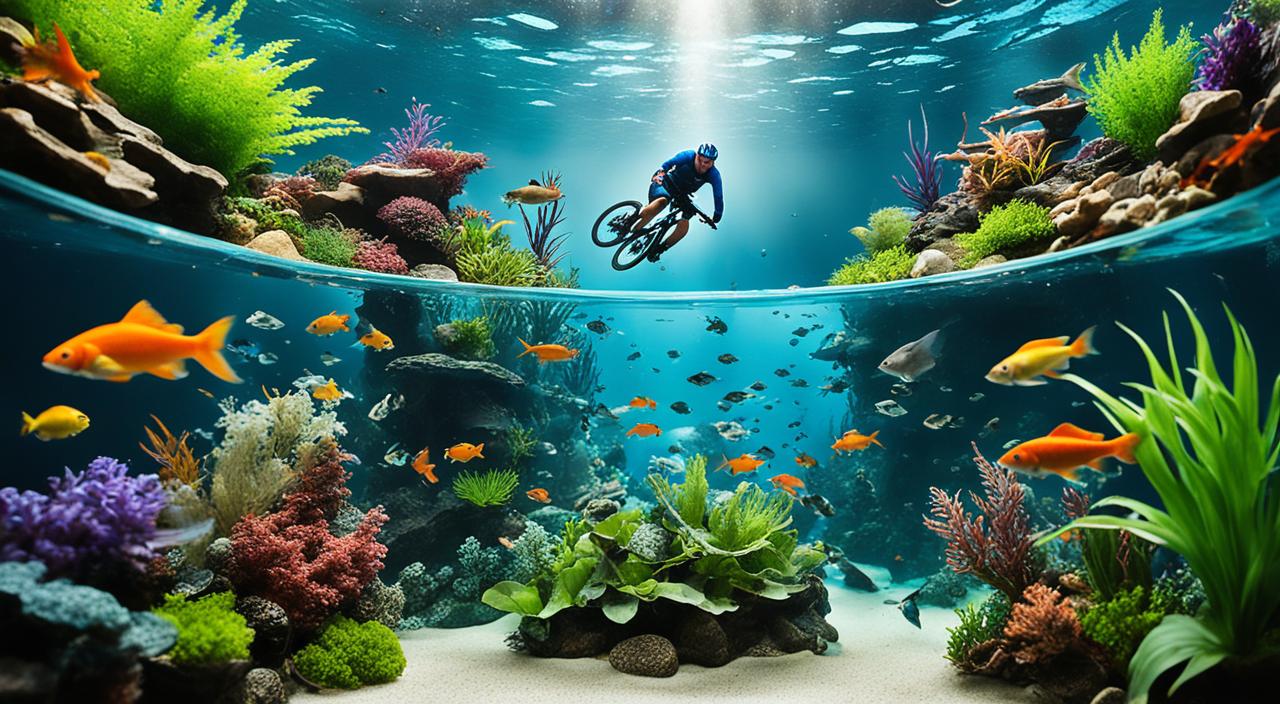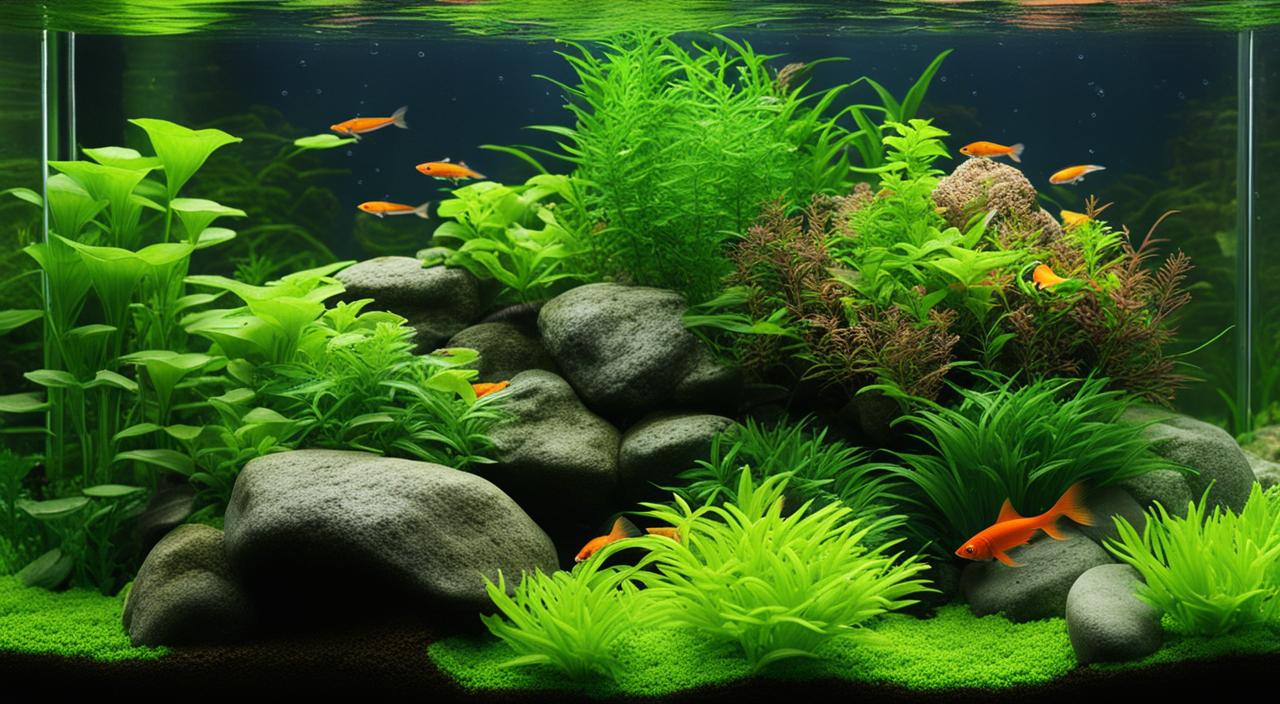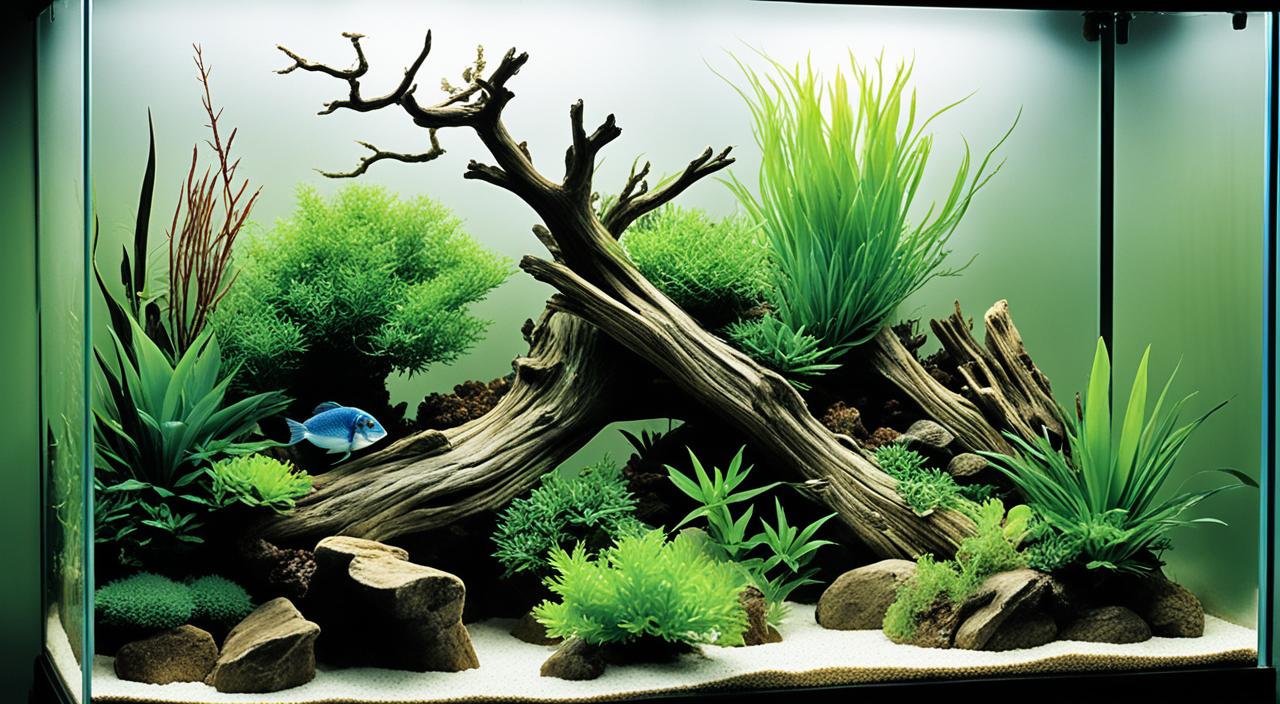Creating a thriving aquatic ecosystem in a planted aquarium requires mastering the cycling process. Understanding the nitrogen cycle and harnessing the power of beneficial bacteria are vital to establishing a healthy cycle in your tank. Additionally, incorporating live plants into your aquarium can significantly speed up the cycling process and provide numerous benefits.
Key Takeaways:
- Cycling is essential for creating a healthy aquatic ecosystem in planted aquariums.
- The nitrogen cycle and beneficial bacteria play crucial roles in establishing a stable cycle.
- Adding live plants to your tank can expedite cycling and provide additional benefits.
- Proper tank setup, including choosing the suitable substrate and installing a sponge filter, is crucial for successful cycling.
- Starting the nitrogen cycle by introducing ammonia and monitoring levels is essential.
The Fishless Method
The fishless method of cycling a planted aquarium is a popular and humane approach that allows you to establish a healthy cycle without adding fish. Using this method, you can ensure the well-being of aquatic life and create a balanced ecosystem. Using the fishless method, let’s explore the step-by-step process of cycling a planted tank without fish.
Step 1: Ammonia Sources
To kickstart the nitrogen cycle, you need a source of ammonia. There are several options for introducing ammonia into your tank. One option is to use fish food as an ammonia source. As the food decomposes, it releases ammonia into the water. Another option is to use ammonia-rich aquasoil, which naturally produces ammonia as it breaks down. Alternatively, you can add pure ammonia or ammonium chloride to the tank. These options provide the necessary ammonia for the cycling process.
Step 2: Emergent and Submerged Plants
Having a combination of emergent and submerged plants in your aquarium is beneficial to speed up the cycling process. Emergent plants, such as pothos or peace lilies, can be partially submerged in the water, with their roots reaching into the tank. These plants help remove excess nutrients and provide a habitat for beneficial bacteria. Submerged plants, like Java moss or Amazon swords, absorb ammonia directly from the water and contribute to the overall stability of the ecosystem.
Step 3: Let Nature Take Its Course
Once you’ve introduced the ammonia source and added your plants, it’s time to let nature take its course. The ammonia will begin to break down, and beneficial bacteria will colonise your tank. These bacteria convert the toxic ammonia into nitrite and break it down into the less harmful nitrate. This process, known as the nitrogen cycle, establishes the biological filtration needed for a healthy aquarium.
During the fishless cycling process, monitoring your water parameters is crucial. Ammonia and nitrite levels will initially spike, but as the cycle progresses, these levels should decrease. You can use test kits to track these levels and ensure the cycling process is on track.
Remember to aerate your water always, as the beneficial bacteria responsible for the nitrogen cycle require oxygen to thrive. Providing good water circulation and using an air pump or a sponge filter will help maintain an oxygen-rich environment for the bacteria.
The fishless method of cycling a planted aquarium requires patience and careful monitoring, but it can be highly rewarding. It allows for a safe and stress-free cycling process, ultimately creating a healthy and stable environment for future fish or other aquatic inhabitants.
The Traditional Method
The traditional method of cycling a planted aquarium involves utilizing the fish-in cycling approach, which relies on the presence of fish to jumpstart the nitrogen cycle. While this method has been used for a long time, there are concerns about its inhumane nature, primarily due to the potential stress and harm caused to the fish during the cycling process. However, advancements in the aquarium industry have provided alternative solutions to make this method safer and more efficient.
Nowadays, live nitrifying bacteria products are available that can significantly speed up the cycling process while ensuring the well-being of the fish. These products contain beneficial bacteria that establish a healthy nitrogen cycle by breaking down toxic ammonia and nitrite into less harmful nitrate. Using live nitrifying bacteria products can minimize the risk of ammonia spikes and provide a more comfortable environment for your fish.
Another way to expedite the cycling process is by using a seeded filter or substrate from an established tank. These materials already contain beneficial bacteria that have undergone the cycling process and can quickly populate your new aquarium, reducing the time it takes to establish a stable nitrogen cycle. Adding a seeded filter or substrate can provide a head start to the bacteria colonization in your tank and create a more favourable environment for fish and plants.
However, it’s important to note that even with these advancements, care must be taken to ensure the well-being of the fish during the cycling process. Selecting hardy fish species that can withstand the potentially fluctuating water parameters is crucial. Choosing species known for their tolerance to cycling conditions, such as danios or guppies, is recommended.
With the traditional method, using live nitrifying bacteria products and incorporating a seeded filter or substrate can help expedite the cycling process and create a safer environment for your fish. By following these techniques, you can establish a thriving planted aquarium while minimizing the stress on your fish.
How Plants Speed up the Cycling Process
Plants play a crucial role in speeding up the cycling process in planted tanks. They directly consume ammonia, a vital component of the nitrogen cycle, and their root systems provide a habitat for beneficial bacteria to populate. This symbiotic relationship between plants and bacteria can lead to faster cycling and a more stable ecosystem in your tank.
When ammonia is present in the tank, plants utilize it as a nutrient source for growth. Plants convert ammonia into organic compounds through ammonium assimilation, effectively removing it from the water. This reduces the ammonia levels and prevents toxic buildup, creating a healthier environment for the fish and other tank inhabitants.
The root systems of plants also play a vital role in the cycling process. As roots grow and extend throughout the substrate, they provide a large surface area for beneficial bacteria to colonize. These bacteria form a biofilm, which helps break down ammonia and convert it into less harmful substances like nitrate. The increased bacteria population enhances the nitrogen cycle’s efficiency, resulting in faster cycling and improved water quality.
Additionally, plants in a planted tank can help stabilize the ecosystem by reducing pH fluctuations. As plants photosynthesize, they absorb carbon dioxide, which lowers the tank’s overall pH. This can be beneficial, especially during the initial stages of cycling when ammonia and nitrite levels are high, as a lower pH reduces the toxicity of these substances.
To take full advantage of the cycling benefits of plants, it is essential to choose species known to be efficient ammonia consumers. Some examples include Anubias, Java Fern, and Amazon Sword. These plants have robust root systems and can thrive in various water conditions.
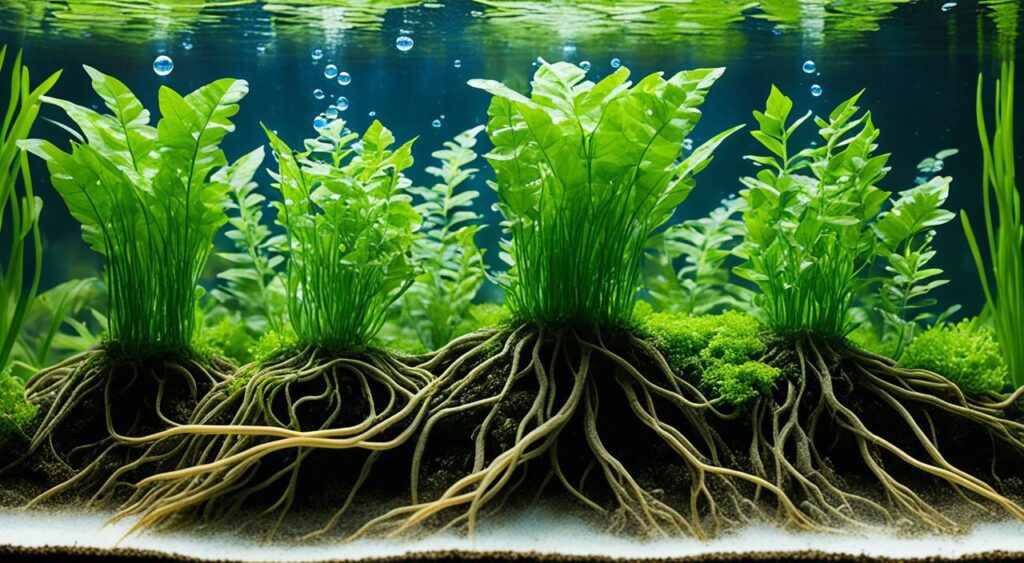
Benefits of Plants in the Cycling Process:
- Direct consumption of ammonia as a nutrient source
- Root systems provide a habitat for beneficial bacteria
- Reduction of ammonia and nitrite levels
- Improved water quality and stability
- Lowering of pH and reduction of toxicity
Set Up Your Tank
Properly setting up your tank is essential for successful cycling. Follow these steps to ensure the ideal conditions for your plants and beneficial bacteria:
- Choose a nutrient-rich substrate: Select a substrate that supports healthy plant growth and provides a source of ammonia for the nitrogen cycle. Options include specialized substrates, such as eco-complete or fluorite, or a combination of potting soil and gravel.
- Set up plants: Clean and trim your plants before planting to remove decaying or damaged parts. This helps maintain the overall health of your tank.
- Capping the soil: If using a soil-based substrate, cap it with sand or gravel to prevent nutrient leaching and ensure stability.
- Fill the tank with dechlorinated water: Tap water contains chlorine and other chemicals that can harm your plants and beneficial bacteria. Use a dechlorinator to remove these harmful substances before filling your tank.
- Install a sponge filter: It provides mechanical and biological filtration, making it an ideal choice for cycling a planted tank. It provides a large surface area for beneficial bacteria to colonize and helps keep the water clean.
By following these steps, you’ll create an optimal environment for your plants and kickstart the nitrogen cycle in your tank.
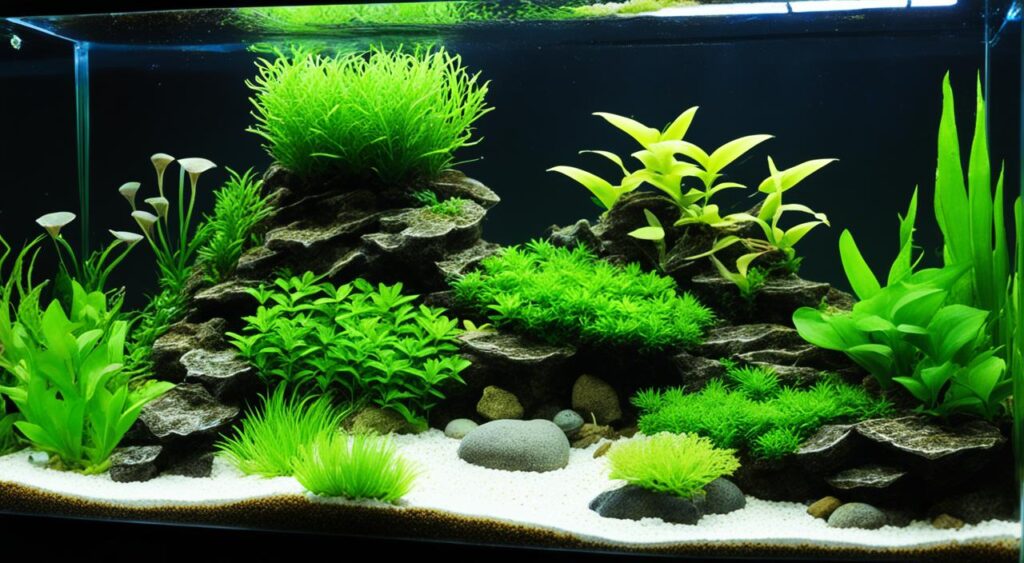
Starting the Nitrogen Cycle
Starting the nitrogen cycle is a crucial step in the cycling process for your planted aquarium. The role of ammonia in this process is key to kickstarting the cycle.
One way to introduce ammonia into your tank is by using a temporary ammonia source, such as ammonium chloride. This compound provides a controlled and safe method of adding ammonia to the water, ensuring the well-being of your plants and future tank inhabitants.
Monitoring ammonia levels is essential during the cycling process. Regular testing using a reliable aquarium test kit will help you track the progression of the cycle. By observing the fluctuations in ammonia levels, you can determine when your tank is ready for the next stage.
Introducing nitrifying bacteria is another critical step in establishing a stable and healthy cycle. These bacteria convert toxic ammonia into nitrites and then into nitrates, which are less harmful to the aquatic environment. You can introduce nitrifying bacteria through commercially available products or by utilizing a seeded filter or substrate from an established tank.
Maintaining consistent water parameters is vital for the success of your nitrogen cycle. Proper temperature, pH levels, and other water parameters will ensure the nitrifying bacteria can thrive and efficiently convert ammonia into nitrates.
It’s also important to track nitrogen levels throughout the cycling process. By regularly testing for ammonia, nitrite, and nitrate levels, you can monitor the progress of the nitrogen cycle and ensure that it is working effectively.
Overall, starting the nitrogen cycle involves introducing ammonia, monitoring its levels, introducing nitrifying bacteria, maintaining water parameters, and tracking nitrogen levels. By following these steps, you can establish a healthy and balanced ecosystem in your planted aquarium.
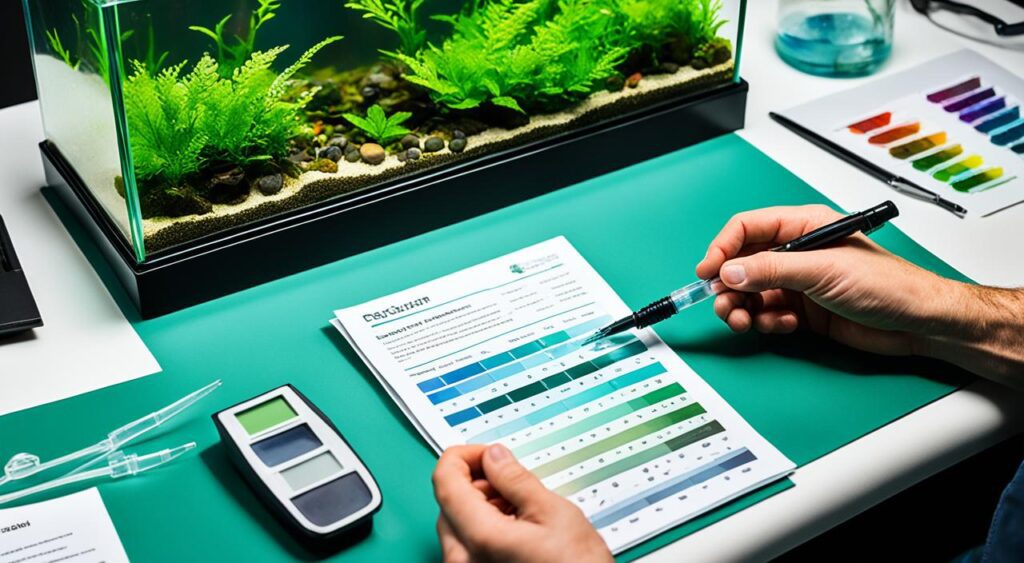
Handling Fluctuations and Introducing Livestock
During the cycling process of your planted aquarium, fluctuations in ammonia and nitrite levels are common and need to be managed effectively. To handle these spikes, it’s crucial to perform partial water changes regularly. By replacing a portion of the water with fresh, dechlorinated water, you can dilute the toxins present in the tank and reduce their harmful effects on your fish and invertebrates.
Monitoring water quality is another important aspect of maintaining a healthy aquarium. Use test kits to regularly check ammonia and nitrite levels, ensuring they stay within safe parameters. This will help you identify any potential issues and take timely action to prevent harm to your aquatic inhabitants.
Once the nitrogen cycle is complete and water parameters have stabilized, it’s time to introduce fish and invertebrates to your tank. It’s recommended to start with hearty species that can tolerate varied conditions, such as guppies or mollies. Gradually introduce more sensitive species, like neon tetras or shrimp, as your tank matures and becomes more stable.
When adding new fish or invertebrates to your tank, it’s essential to acclimate them properly. Float the sealed bag containing the fish or invertebrates in the tank for about 15-20 minutes to help them adjust to the water temperature. Then, slowly add small amounts of tank water to the bag at regular intervals. This gradual mixing of water will allow the aquatic creatures to adapt to the tank’s water chemistry. Finally, use a net to transfer the fish or invertebrates into the tank, taking care to avoid adding the water from the bag into your aquarium.
FAQ
What is the nitrogen cycle in an aquarium?
The nitrogen cycle is a natural process that converts toxic ammonia from fish waste into less harmful nitrates. It involves the growth of beneficial bacteria that break down ammonia into nitrites and further into nitrates.
How does cycling a planted tank work?
Cycling a planted tank involves establishing a healthy nitrogen cycle by introducing a source of ammonia and allowing beneficial bacteria to grow. These bacteria convert ammonia into nitrites and then nitrates, which can be utilized by the plants in the tank.
What are the benefits of cycling with live plants?
Live plants consume ammonia directly, helping to reduce ammonia spikes in the tank. They also provide a habitat for beneficial bacteria to thrive, which aids in the cycling process and creates a more stable ecosystem.
What is the fishless method of cycling a planted aquarium?
The fishless method is a humane approach to cycling that involves introducing ammonia to the tank without adding fish. This method allows the nitrogen cycle to establish itself naturally, without causing stress or harm to fish.
How can I start the nitrogen cycle in my planted tank without fish?
You can start the nitrogen cycle in a fishless tank by adding ammonia from various sources such as fish food, ammonia-rich aquasoil, or using pure ammonia or ammonium chloride. By monitoring ammonia levels and allowing nature to take its course, the cycle will establish itself.
What is the traditional method of cycling a planted aquarium?
The traditional method involves cycling the tank with fish to initiate the nitrogen cycle. However, this method is considered by some as inhumane. Alternatively, live nitrifying bacteria products or a seeded filter or substrate from an established tank can be used to speed up the cycling process.
How can plants help speed up the cycling process in a planted tank?
Plants directly consume ammonia, which is a key component of the nitrogen cycle. Additionally, their root systems provide a habitat for beneficial bacteria to populate, leading to faster cycling and a more stable ecosystem in the tank.
What should I consider when setting up my tank for cycling?
Choose a nutrient-rich substrate that supports healthy plant growth and provides a source of ammonia. Clean and trim your plants before planting them, and cap the soil with sand or gravel to prevent nutrient leeching. Install a sponge filter, which creates an ideal environment for beneficial bacteria.
How do I start the nitrogen cycle in my planted tank?
Add a temporary source of ammonia, such as ammonium chloride, to jumpstart the cycle. Monitor ammonia levels and introduce nitrifying bacteria to establish a stable and healthy cycle. Maintain consistent water parameters and track nitrogen levels to ensure the process is progressing correctly.
What should I do during ammonia and nitrite spikes in the cycling process?
To handle spikes in ammonia and nitrite levels, perform partial water changes and closely monitor water quality. This helps to reduce the toxic levels and prevent harm to the plants and any potential livestock. Once water parameters stabilize, you can introduce fish and invertebrates to your tank.

